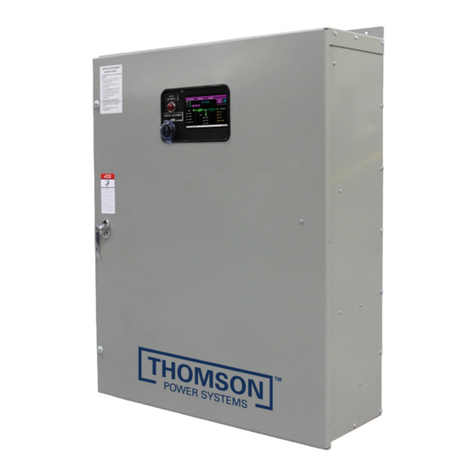TS 880 Transfer Switch
PM178 REV 0 23/02/20 6 Thomson Power Systems
Refer to information supplied with the transfer switch documentation package for adjustment
procedures on the power switching units over current protection trip unit. Contact the factory if
any additional information is required.
3.3. TRANSFER SWITCHES WITH MULTI-TAP VOLTAGE CAPABILITY
If the transfer switch has programmable multi-tap voltage capability (refer to engineered
drawings), confirm the transfer switch has been configured for the correct system voltage prior
to installation.
WARNING
Failure to confirm and match transfer switch voltage with the system
voltage could cause serious equipment damage.
The voltage selections and connections are shown on the engineered drawings attached to
each transfer switch. The factory default settings will be indicated on the calibration label
attached on the inside of the enclosure door (supplied loose on open style models). A blank
label is included to record the applicable settings if the configuration is changed from the
factory default settings.
To change the transfer switch voltage, refer to Instructions To Change System Voltage On
TS 880 Series Transfer Switches With TSC 7320 Controller, attached as Appendix B. Contact
Thomson Power Systems for further information as may be required.
3.4. REMOTE START CONTACT FIELD WIRING
As a minimum, the remote engine start control field wiring shall conform to the local regulatory
authority on electrical installations. Field wiring of a remote start contact from a transfer switch
to a control panel should conform to the following guidelines to avoid possible controller
malfunction and/or damage.
3.5.1. Minimum #14 AWG (2.5mm2) wire size shall be used for distances up to 100ft
(30m)1). For distances exceeding 100 ft. (30m) consult Thomson Power Systems
3.5.2. Remote start contact wires should be run in a separate conduit.
3.5.3. Avoid wiring near AC power cables to prevent pick-up of induced voltages.
3.5.4. An interposing relay may be required if field-wiring distance is excessively long
(i.e. greater than 100 feet (30m)) and/or if a remote contact has a resistance of greater
than 5.0 ohms.
3.5.5. The remote start contact must be voltage free (i.e. dry contact). The use of a
Powered contact will damage the transfer controller.




























